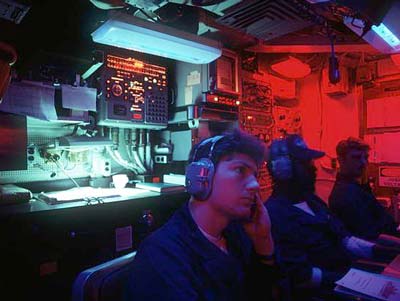Light does not penetrate very far into the ocean, so submarines must navigate through the water virtually blind. However, submarines are equipped with navigational charts and sophisticated navigational equipment. When on the surface, a sophisticated global positioning system (GPS) accurately determines latitude and longitude, but this system cannot work when the submarine is submerged. Underwater, the submarine uses inertial guidance systems (electric, mechanical) that keep track of the ship's motion from a fixed starting point by using gyroscopes. The inertial guidance systems are accurate to 150 hours of operation and must be realigned by other surface-dependent navigational systems (GPS, radio, radar, satellite). With these systems onboard, a submarine can be accurately navigated and be within a hundred feet of its intended course.
To locate a target, a submarine uses active and passive SONAR (sound navigation and ranging). Active sonar emits pulses of sound waves that travel through the water, reflect off the target and return to the ship. By knowing the speed of sound in water and the time for the sound wave to travel to the target and back, the computers can quickly calculate distance between the submarine and the target. Whales, dolphins and bats use the same technique for locating prey (echolocation). Passive sonar involves listening to sounds generated by the target. Sonar systems can also be used to realign inertial navigation systems by identifying known ocean floor features.

Sonar station onboard the USS La Jolla nuclear-powered attack submarine


